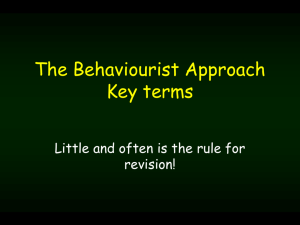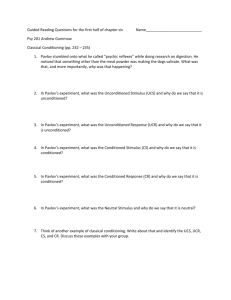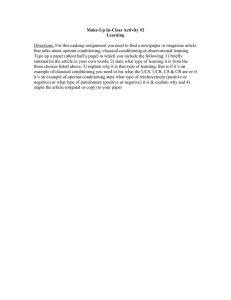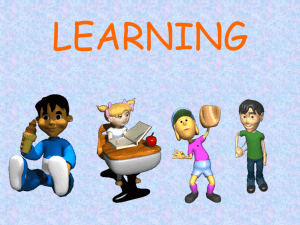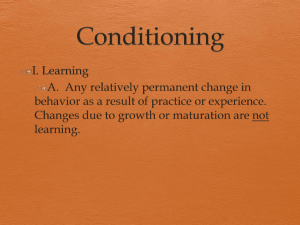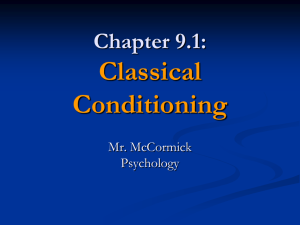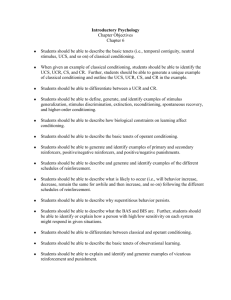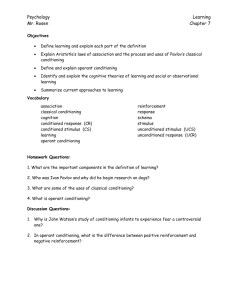Learning and Classical Conditioning
advertisement
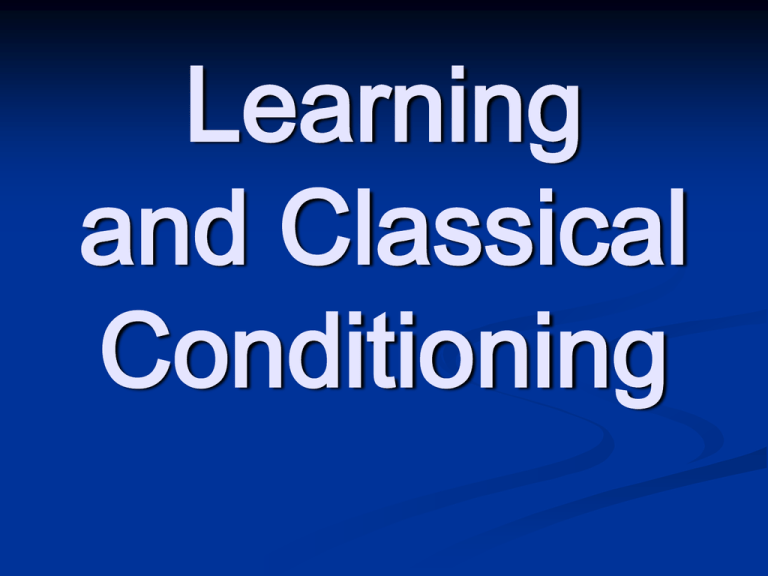
Learning and Classical Conditioning Agenda 1. Bell Ringer: Quick Questions (5) 2. Classical Conditioning and Pavlov (20) 3. Jim and Dwight… (5) 4. Little Albert Video… Ethical? (10) 5. Squirt Experiment and Analysis (15), chart activity 6. Taste Aversion Survey (5) Bellringer How would you teach a dog not to jump on guests as they walk in the door? Why does Mr. Throckmorton’s dog Shiner lay down in the kitchen every day around 6:00? How would you teach a five year old to put their toys away? Learning A relatively permanent change in an organism’s behavior due to experience or practice How do we learn? We learn by association. Our minds naturally connect events that occur in sequence. Aristotle- 2000 years ago, he suggested the law of association John Locke & David Hume- 200 yrs ago, they reiterated this law Associative Learning Learning that certain events occur together The events can be two stimuli or a response and its consequences Associative Learning: Stimulus-Stimulus Learning Associative Learning: Response-Consequence Learning Associative Learning: Response-Consequence Learning Conditioning The process of learning associations. Classical – 2 stimuli and anticipate events Operant – response and consequence (good/bad) Classical Conditioning The behavioral technique of pairing a naturally occurring stimulus with a different stimulus in order to produce a response which is not naturally occurring. Ivan Pavlov 1849-1936 father of classical conditioning 1904 Nobel Peace Prize winner Pattern for classical conditioning Stimulus – ReinforcementResponse Classical Conditioning Terms UCS – Unconditioned stimulus – stimulus that naturally or automatically triggers a response Classical Conditioning Terms – Unconditioned response – unlearned naturally occurring response to UCS UCR Classical Conditioning Terms – elicits no response CS – Conditioned stimulus – irrelevant stimulus that after association with UCS, comes to trigger a conditioned response Neutral Classical Conditioning Terms – Conditioned response – learned response to a previously neutral CS CR Remember… Conditioned = learned Unconditioned = unlearned Jim trains Dwight on The Office What was the UCS? ________________________ What was the UCR? ________________________ What was the NS? ________________________ What was the CS? ________________________ What was the CR? ________________________ Acquisition The process of learning a conditioned response by introducing a neutral stimulus before the UCS Conditioning is faster w/less time between CS and UCS due to repeated pairings; best time is about half a second Acquisition 23 Extinction The process of unlearning or removing a conditioned association. Break link between CS and UCS Spontaneous Recovery The reappearance, after a rest period, of an extinguished conditioned response. Generalization The tendency, once a response has been conditioned, for stimuli similar to the CS to elicit similar responses. Discrimination The learned ability to distinguish between a CS and other stimuli that do not signal a UCS Example A person is sitting in a chair. Ring a bell and then have the chair fall partially backwards causing the person to most likely grab the sides of the chair. Repeat a few times and then just ring the bell so the person will tense up and grab the sides of the chair. Identify the following in the sample 1. unconditioned stimulus 2. unconditioned response 3. conditioned stimulus 4. conditioned response 5. generalization 6. discrimination 7. spontaneous recovery 8. extinction 1.UCS– chair falling backwards 2.UCR– tensing up and grabbing sides of chair 3.CS– ringing bell 4.CR– tensing up and grabbing sides of chair at ringing 5. generalization –hearing the school bell ring elicits a similar response 6. discrimination –hearing a cell phone ring and no response occurs 7. spontaneous recovery – waiting a day and ring a bell, response happens again 8. extinction –wait a week, ring a bell and no response Your Assignment Create two different scenarios like my example. Identify the eight terms for each scenario. Pavlov’s Legacy Pavlov’s greatest contribution to psychology is isolating elementary behaviors from more complex ones through objective scientific procedures. Importance of Pavlov’s work Classical conditioning is one way that organism’s learn to adapt to their environment. Proved that the process of learning can be studied objectively. Apply Pavlov’s Principles to Human Health and Well Being Advice former addicts to steer clear of settings associated with addiction. Counselors provide alcoholics with experiences that may reverse their positive associations with alcohol. Classical conditioning may explain some emotional disorders like phobias. John B. Watson and Little Albert Baby Albert Video Watch and see how baby Albert is conditioned. Little Albert Rat – Neutral stimulus = no response Loud noise (UCS) = crying and attempt to crawl away (UCR) During conditioning: Rat – loud noise = crying and crawling away (NS) (UCS) (UCR) After Conditioning: Rat (CS) = Crying and crawling away (CR) John B. Watson Watson later used classical conditioning procedures to develop advertising campaigns for a number of organizations, including Maxwell House, making the “coffee break” an American custom. Cognitive Processes Early behaviorists believed that learned behaviors of various animals could be reduced to mindless mechanisms. However, later behaviorists suggested that animals learn the predictability of a stimulus, meaning they learn expectancy or awareness of a stimulus (Rescorla, 1988). Biological Predispositions Pavlov and Watson believed that laws of learning were similar for all animals. Therefore, a pigeon and a person do not differ in their learning. However, behaviorists later suggested that learning is constrained by an animal’s biology. Biological Predispositions John Garcia showed that the duration between the CS and the US may be long (hours), but yet result in conditioning. A biologically adaptive CS (taste) led to conditioning and not to others (light or sound). John Garcia Biological Predispositions Even humans be classically conditioned to develop nausea.
